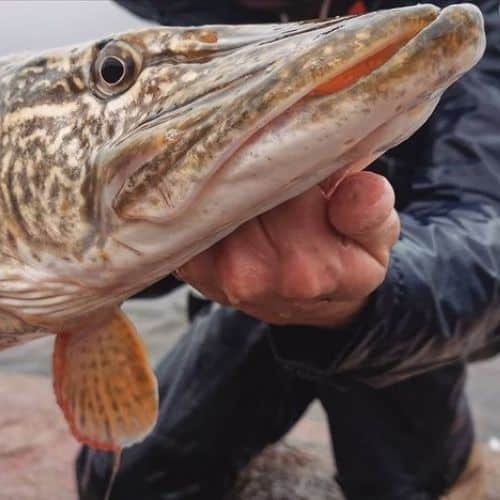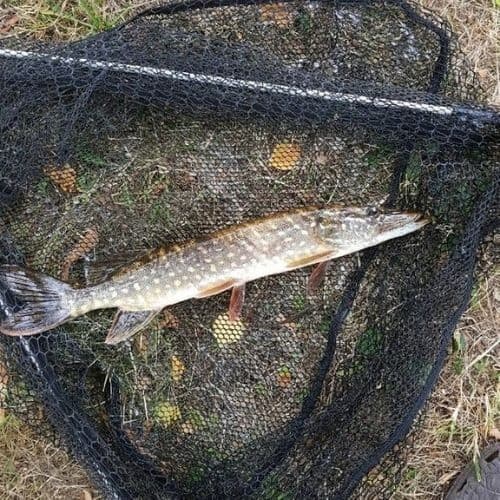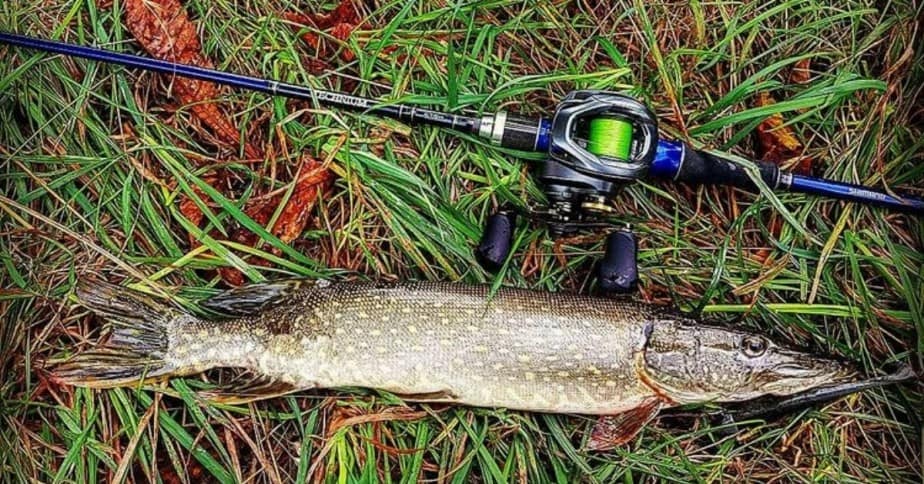Pike is a remarkable fish. This fish, which tops the food chain in most habitat it find itself, boast of features that echo its predatory capabilities. Pikes is a fish I’ll like to regard as a badass predator; one of the few in the aquatic world. You see, catching pike consistently is the dream of several anglers, including probably yourself. And to actualize this dream, you need to be privy to some effective pike fishing tips that few people discuss.
When pike fishing, channel your attention to shallower weedy areas such as bays and flats. Also, ensure you cover enough water with moving baits. Don’t stay in a location for too long if you aren’t catching anything. Use baits that are made of bright colors – white, chartreuse, and bright orange.
Pikes are very aggressive and would eat anything that isn’t larger than them. The feeding habit and aggressive nature of this fish make them a little easy to catch. However, if you lack the tactics, tackle, and proper understanding of this fish, you will struggle. See, to be a good piker, you need to understand the nature of this fish and know the tips that are very effective and not common. And as we progress, I’ll be providing you with those tips on a platter.
Pike Fish:
| Average Length: | 40–55 cm (16–22 in) |
| Maximum Recorded Length: | 150 cm (59 in) |
| Maximum Recognized Weight: | 25 kg (55 lb) |
| Appearance: | Most often olive green, shading from yellow to white along the belly. The flank is marked with short, light bar-like spots and a few to many dark spots on the fins. |
| Life Cycle: | 10-15 years. In some cases up to 25 years. |
| Habitat: | Found in fresh water throughout the Northern Hemisphere, including Russia, Europe, and North America. |
| Aggression: | Very aggressive species, especially with regards to feeding. |
Learn more about 4 best pike rods which are efficient, reliable and very affordable!
Pike Fishing Tips Not Too Many Talk About:
Pike fishing can be as difficult as nailing jelly to a tree, and it can be as easy as ABC. If you do everything right; that is, if you adopt the right tackle, fish in the right location and in the right way, you’d love fishing for pike and probably include it in your hobby list. However, If you fail to follow due protocol, you will hate it and find it pretty boring. So, before we delve further, let’s take a closer look at some essential things you ought to know about this fish.
Pike is a specie of the genus Exos. This predator, which has an elongated body, long teeth and bulging eyes, is native to North America and a portion of Eurasia. Due to their nature, a pike will aggressively chase down large baits. Their food preference ranges from small mammals, fish, frogs, little birds, and anything that can enter their teeth-filled mouth.
You can find pikes in several places, but covers like vegetation are usually one of their favorite spots. Slow streams, shallows, and weedy lakes are also places you’d want to look at when hunting for this fish. When hunting pike, it is vital that you pay attention to their prey. These fish species hunt in packs so wherever their prey is, there is a likelihood that you’d find a few pikes hiding in the shadows waiting to strike.
The details mentioned above are meant to give you a little peek into this fish’s preference and character. However, wielding such information isn’t enough to capture this fish. You need to know the tackles and tactics to adopt. You also need an effective tip one that is tested and trusted. As we progress, I’ll be revealing to you the appropriate tackle for this fish. I’ll also disclose uncommon, rarely talked about, and effective ways to catch this fish.
Learn more about the best reels for pike which are being used by PRO anglers.
What Is The Best Bait For Pike Fishing?
Pikes being the aggressive predator that they are will attack anything that looks appealing. The trick to catching pikes is still the same for other terrestrial or aquatic animals: present bait and wait for the fish to take it. Lots of anglers select the wrong bait when hunting this fish, and this mistake often comes back to bite them. If you want a pike to aggressively attack any bait you’d be putting out there; you must ensure that you use the best.
Baits come in two types; natural and artificial baits. The best natural bait for pikes is perch, while the best artificial bait for this fish is spinners like Mepps 5 or the big blue fox. For dead bait, soft rayed fish, smelt, chubs, and alewives are your best bet.
It is crucial that you use the right bait and more crucial that you match the bait with the size of fish you intend to catch. This means that you must use a big bait if you are targeting a big pike, and vice versa. For little pikes, adopt minnows and other small baits, while for bigger pikes use perch.

When selecting a bait, it is also essential that you research your fishing location. Generally, the bigger the lake, the bigger the pike prey, and the bigger the pike prey, the larger the pike. So, this means that when fishing in a large lake, you’ll need a big bait. Other baits to use for this fish are spoons, rattle traps, plastics, jig walleye, and crankbaits.
Learn more about the best lures for pike fishing.
What Is The Best Time to Fish For Pike?
There are several anglers out there who aspire to be a pro piker. However, only a few have what it take to live up to that level. To be a pro piker, there are several things you need to know about this fish. Firstly, you need to know where to locate this fish, the tackle to use, including its preys. Also, you need to understand how this fish behaves in different environment and weather conditions. And lastly, you need to know the right time to catch this fish.
The best time to catch pike is around late May and early June. These months are also the ideal time to target huge pikes. You can also target these fish during spring, which is after the spawning season.
Those who catch pikes consistently know where and when to fish. These individuals aren’t magicians; neither are they soothsayers. They understand the behavior of these fish regarding certain periods. So, if you are eager to capture lots of this fish, I’ll advise you hit the water during the times as mentioned above.
For huge pikes, late May and early June are your best bet. Pikes also love cool water so there is a huge chance that you’ll find lots of them during the fall to the spring season. Ensure you do your homework before you start fishing to ensure that you aren’t fishing during a closed season.
Learn more about pike fishing seasons and restrictions.
What Is The Best Way To Catch Pike?
Pike is a very popular game fish which can be caught in several ways. You can decide to catch this fish via trolling. You can choose to catch this fish with a lure, a live bait or from the shore. Whichever technique you use is OK. But, if you want to be better than your colleagues; if you’re going to catch lots of this fish without stress, you need to adopt the best technique and know the best way to capture this fish?
The best way to capture pike is with the use of dead bait. Dead baits are effective in several conditions such as murky water, rivers, including clear and still water. The best dead bait for this fish are smelts, alewives, small whitefish, suckers, mackerel, sprat, and sardine.
Fishing for pike with dead bait is the most effective way to catch this fish, and this is because of the scent they emit. Being predator, Pikes have high senses, thus making them more likely to go after a dead bait than any other bait. This doesn’t mean a lure isn’t effective in catching this fish. Lures are good, but dead baits are far better.
It is crucial to note that not all dead baits are effective in arousing this fish’s attention. So always remember to go for dead baits that have strong scents. You can get these baits frozen from tackle shops or fresh from fishmongers or supermarkets.
Learn more about the tips not many share while fishing for pike at night.
What Depth Do You Fish For Pike?
Depth is a significant factor to consider when you fish for pike. Of course, the first step to catching this fish is knowing where to fish, and this also includes knowing the appropriate depth to catch this fish. Failure to know this will leave you moving around like a lost child. You see, when you know the right depth to find this fish, fishing becomes easy and very enjoyable.
Most pikes are shallower, they inhabit shallow waters and hunt for preys. The big ones, however, are deep dwellers. Most times, they dive as deep as 15 feet or more. At a time like this, you’ll need to equip yourself with a deep running lure.
Fishing depth also varies for each season. For instance, during the cold seasons, these fish dive deep in search of warmer water. While during summer, pikes come to the surface. They amble around shallow water and hide in covers like vegetation and the likes. In spring, this fish roam shallow bays and can be best caught with the help of lures.

The depth you fish will also affect your choice of tackle. When fishing deeper depth for pikes, you will want to use a reel designed for such depth. The rod you choose must also be long and strong enough to make casting easy. Speaking of lures, if you are targeting big pikes, who dive deep, consider these lures:
- Mepps Magnum Musky Killers
- Tandem Musky and Giant Killers
- Mepps H210
What Colors Do Pike See Best?
When fishing for pikes, you must ensure that all you use, be it your tackle or technique, is designed to capture this fish. What do I mean? For instance, you wouldn’t want to go after a mature pike with a feeble rod or reel; you’d lose. In the same vein, when selecting lures, you must use a color that this fish finds attractive to augment your chances of getting it to bite.
Pikes are predatory fish with improved senses, especially visuals. These fishes are attracted to bright colors like white, chartreuse, and bright orange. Provided the color highly-visible and flashy, it’ll get the attention of this fish.
To novice anglers, catching pike is simply about hitting the water, attaching bait to your hook and casting it. However, to professional anglers, it is more than that. To catch pike, you need to be conscious with your selections, starting from clothes you wear down to the color of lure you use.
The color of lure you use when hunting this fish is essential. If you get your selection wrong, these fishes will end up ignoring your lure the same way you ignore unappealing commercials. So, what color of lures do you use? Chartreuse, bright orange, white, and anything bright and highly visible would work. However, at nights, you may need to adopt a different color.
When night fishing for pike, bright-colored lures may be less effective due to the dark surrounding and the lack of visibility. So, when fishing during this time use black colored lures as it is very visible even in the dimmest moonlight.
What is The Best Weather When Fishing For Pike?
Weather is a significant factor to look out for. Professional anglers fish when the weather is right, and they often end of catching lots of pikes. Novice anglers, on the other hand, fish anytime they like which is wrong. If you are a piker, knowing the right weather to fish will improve your chances of catching this fish.
The best weather to target this fish is mild and cloudy weather conditions. You can also target this fish during shorter-lived rains and storms. However, consistent cold spells can make catching this fish challenging. And it often gets more complicated when the river is flooded and heavily colored.
Weather affects pikes just as it affects humans and other animals. So you must fish when the weather is right if you don’t want to end up being frustrated. You see, these species of fish are very active during certain weather and knowing the weather that this fish enjoys the most will be instrumental in your efforts in catching this fish.
Visit weather forecast platforms to have a good idea of the weather for a particular day. Also, have it in mind that you may need to adopt different tackle and techniques for each weather condition.
Where Do Big Pikes Hang Out?
The biggest pike to be caught weighed 22kg (55lb), and it was caught by Louis on Greffern Lake in Germany on 16 October 1986. Till date, this long-time record remains unbroken. However, I am sure that several anglers out there are keen to shatter this record and write their name in history. If you are in that category, one question you should be asking yourself is “Where do big pikes hang out?”
Big pikes hang out in deeper waters and ambush preys like Walleyes from below. You can also find them at the narrows between islands and shoals. These fishes can also be found in the mouth of feeder streams. They usually move into the streams to consume preys like chubs and suckers.
It is the dream of every piker to catch a giant pike. But I’ve come to understand that most people lack the knowledge to make this dream a reality. You see, big pikes are easy to find if you know where to look. These fishes aren’t invisible like some anglers believe. So with the right tackle (very important), the right technique, and the right information on this fish’s location, you can etch your name in the history books and be remembered for years to come.
What Type of Lure Do Pike Like?
Pike is a predatory fish that is caught in several parts of the world. These fish species are aggressive eaters and will attack anything that looks appealing. With that said, the best way to get the attention of this fish is by presenting a lure that it can’t resist. However, to do this, you need to know the types of lures that this fish like and present it to them in the best way.
Pikes like any type of spinners. But one lure this fish finds hard to resist is the Mepps 5. So, you can use any spinner, provided it has a bright color, and it vibrates. Other spinners to consider are the blue fox (silver and blue or gold color work best).
Lure fishing is among the best ways to catch pikes. However, anglers often make the mistake of selecting the wrong lure. When it comes to lure selection, it is important that you pay attention to the color of the lure. Aside from spinners, you can also consider soft lures, crankbaits, and swim lures. Remember, always go for lures that are very attractive, possibly one that comes in these colors: white, chartreuse, and bright orange.
You must also have it in mind that if you don’t match the lure you use with your rod and reel, you may encounter challenges due to lack of balance. So always look out for balance when selecting your tackles.
